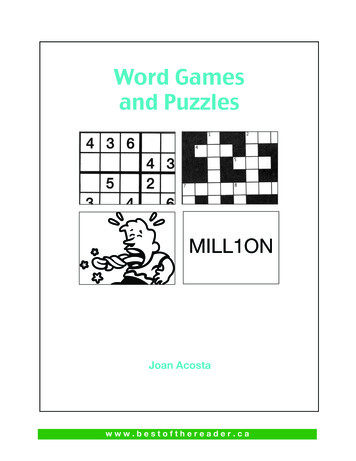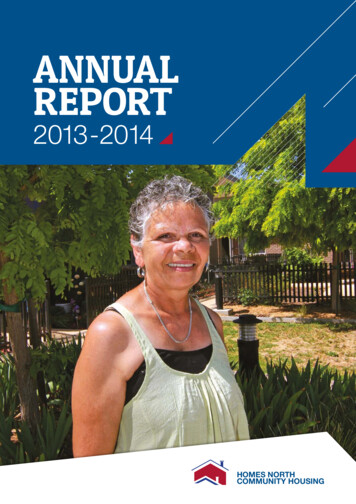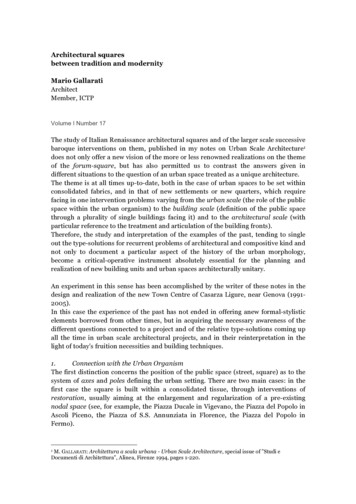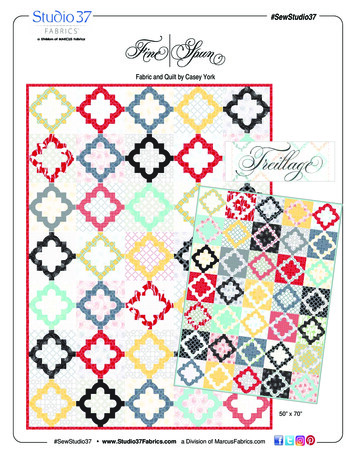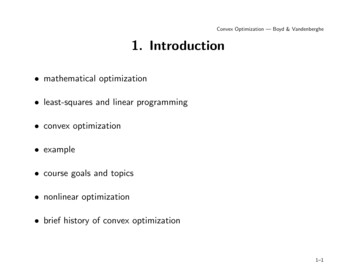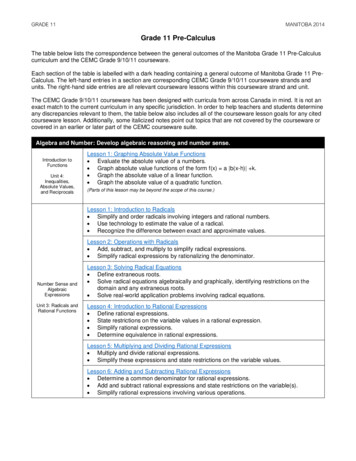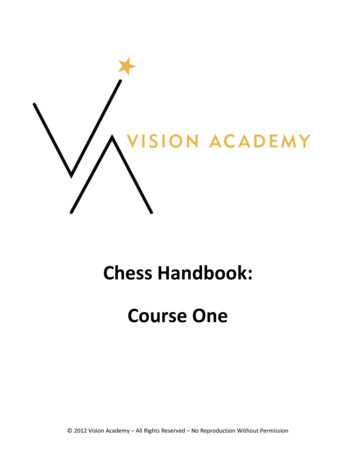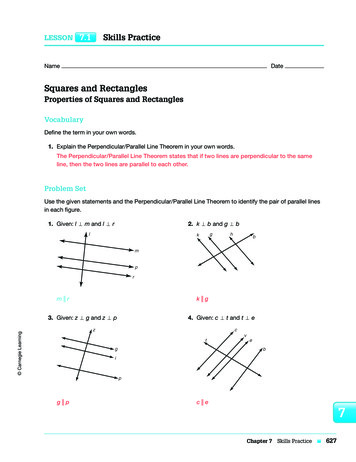
Transcription
Lesson 7.1Skills PracticeNameDateSquares and RectanglesProperties of Squares and RectanglesVocabularyDefine the term in your own words.1. Explain the Perpendicular/Parallel Line Theorem in your own words.The Perpendicular/Parallel Line Theorem states that if two lines are perpendicular to the sameline, then the two lines are parallel to each other.Problem SetUse the given statements and the Perpendicular/Parallel Line Theorem to identify the pair of parallel linesin each figure.1. Given: l m and l r2. k b and g blgkhbmprm r k g Carnegie Learning3. Given: z g and z p4. Given: c t and t ezctgvebipg p c e7Chapter 7 Skills Practice627
Lesson 7.1Skills Practice5. Given: n r and r qynq vpage 26. Given: b x and k bbxrezkn q x kComplete each statement for square GKJH.GKEHJ7. GK KJ JH HG 8. /KGH / GHJ / HJK / JKG / GEK / GEH / HEJ / JEK9. /GEK, / KGH , / GHJ , / HJK , / JKG , / GEH , / HEG , and / JEK are right angles. 10. GK HJand GH KJ HE KE 11. GE JE Carnegie Learning12. / KGE / EGH / GHE / EHJ / HJE / EJK / JKE / EKG7628Chapter 7 Skills Practice
Lesson 7.1Skills Practicepage 3NameDateComplete each statement for rectangle TMNU.MNLTU and MT 13. MN TU NU14. /NMT / TUN / UNM / MTU15. /MTU, / TUN , / UNM , and / NMT are right angles. 16. MN TUand MT NU 17. MU NT TL 18. ML UL TUConstruct each quadrilateral using the given information.19. Use AB to construct square ABCD with diagonals AC and BD intersecting at point E.AB Carnegie LearningDCEAB7Chapter 7 Skills Practice629
Lesson 7.1Skills Practicepage 4 and XZ intersecting at point P.20. Use WX to construct square WXYZ with diagonals WYWXZYPWX21. Use OP to construct square OPQR with diagonals OQ and PR intersecting at point T.OPPOTQ Carnegie LearningR7630Chapter 7 Skills Practice
Lesson 7.1Skills Practicepage 5NameDate22. U se RE to construct rectangle RECT with diagonals RC and ET intersecting at point A. Do notconstruct a square.RETCARE23. U se QR to construct rectangle QRST with diagonals QS and RT intersecting at point P. Do notconstruct a square.QRTS Carnegie LearningPQR7Chapter 7 Skills Practice631
Lesson 7.1Skills Practicepage 6 and NP intersecting at point G. Do not24. U se MN to construct rectangle MNOP with diagonals MOconstruct a square.MNMNGPOCreate each proof.25. Write a paragraph proof to prove AC BD in square ABCD.BDCYou are given square ABCD with diagonals AC and DB . By definition of a square, /ADC and/BCD are right angles. Because all right anglesare congruent,you can conclude that/ADC /BCD. Also by definition of a square, AD BC . By the ReflexiveProperty,DC DC .Therefore, n ADC n BCD by the SAS Congruence Theorem. So, AC BD by CPCTC.7632Chapter 7 Skills Practice Carnegie LearningA
Lesson 7.1Skills Practicepage 7NameDate26. Write a paragraph proof to prove GL IL and HL JL in square GHIJ.HGLIJYou aregiven squareGHIJ and JH intersecting at point L. By definition of awithdiagonals GIsquare, GH JI . Also, GH JI , because opposite sides of a square are parallel. Because /HGIand /GIJ are alternate interior angles to the parallel lines, it can be determined that /HGI /GIJby the Alternate Interior Angle Theorem. It also follows that /GLH and /JLI are vertical angles, so/GLH /JLIby the VerticalAngleTheorem. Therefore, nGHL nIJL by the AAS CongruenceTheorem. So, GL IL and HL JL by CPCTC.27. Create a two-column proof to prove ML NP in square MNLP.MNQLP Carnegie LearningStatementsReasons1. Square MNLP with diagonals ML and NP intersecting at point Q1. Given2. MN PM 2. Definition of a square3. PQ QN 3. Diagonals of a square bisect each other4. MQ MQ 4. Reflexive Property5. nPMQ nNMQ5. SSS Congruence Theorem6. /PQM and /NQM are supplementary.6. Definition of Linear Pair7. /PQM /MQN7. CPCTC8. /PQM and /MQN are right angles.8. If two angles are supplementary andcongruent, then they are right angles.9. ML NP 79. Definition of perpendicular linesChapter 7 Skills Practice633
Lesson 7.1Skills Practicepage 8 in rectangle RSTU.28. Create a two-column proof to prove RT SURSVTUStatementsReasons1. Rect RSTU with diagonals US and RT intersecting at point V1. Given2. /RUT and /STU are right angles.2. Definition of a rectangle3. /RUT /STU3. All right angles are congruent.4. UT UT 4. Reflexive Property5. RU ST 5. Opposite sides of a rectangle arecongruent6. nURT nTSU6. SAS Congruence Theorem7. RT SU 7. CPCTC Carnegie Learning7634Chapter 7 Skills Practice
Lesson 7.1Skills Practicepage 9NameDate29. Create a two-column proof to prove LK KN and OK KM in rectangle LMNO.MLKONStatementsReasons1. Rect LMNO with diagonals LN and OM intersecting at point K1. Given2. LO MN 2. Opposite sides of a rectangle arecongruent.3. /LKO /MKN3. Vertical Angle Theorem4. LMLO and perpendicular to perpendicular to ONLO 4. Definition of perpendicular lines5. LO parallel to MN 5. Perpendicular/Parallel Line Theorem6. /OLN /MNL/LOM /NMO6. Alternate Interior Angle Theorem7. nOLK nMNK7. AAS Congruence Theorem8. LK NK 8. CPCTC OK MK 30. Write a paragraph proof to prove opposite sides are parallel in rectangle WXYZ. Carnegie LearningWXAZYYou are given rectangle WXYZ. By definition of a rectangle, /ZWX,/WXY,/XYZ, ines,itfollowsthatWX XY , XY ZY , ZY WZ ,and WZ WX . Therefore, by the Perpendicular/Parallel Line Theorem, WX i ZY and WZ XY , oropposite sides of the rectangle are parallel.Chapter 7 Skills Practice7635
Carnegie Learning7636Chapter 7 Skills Practice
Lesson 7.2Skills PracticeNameDateParallelograms and RhombiProperties of Parallelograms and RhombiVocabulary1. E xplain how the Parallelogram/Congruent-Parallel Side Theorem can be used to determine if aquadrilateral is a parallelogram.If a quadrilateral has one pair of opposite sides congruent and parallel then the Parallelogram/Congruent-Parallel Side Theorem states that the quadrilateral is a parallelogram.Problem SetComplete each statement for parallelogram MNPL.MNRLP and ML 1. MN LP NP2. /NML / LPN and /MLP / MNP and ML 3. MN LP NP Carnegie Learning and LR 4. MR RP RN7Chapter 7 Skills Practice637
Lesson 7.2Skills Practicepage 2Complete each statement for rhombus UVWX.UVEXW WX XU 5. UV VW6. /UVW / UXW and /XUV / VWX and UX 7. UV XW VW and XE 8. UE EW EVConstruct each quadrilateral using the given information.9. Use RS to construct parallelogram RSTU with diagonals RT and SU intersecting at point G.RSUTGS Carnegie LearningR7638Chapter 7 Skills Practice
Lesson 7.2Skills Practicepage 3NameDate10. Use AB to construct parallelogram ABCD with diagonals AC and BD intersecting at point F.ABCDFAB11. Use WX to construct parallelogram WXYZ with diagonals WY and XZ intersecting at point H.WXYZHXW12. U se AB to construct rhombus ABCD with diagonals AC and BD intersecting at point K. Do notconstruct a square.B Carnegie LearningACDKAB7Chapter 7 Skills Practice639
Lesson 7.2Skills Practicepage 4 and XZ intersecting at point V. Do not13. U se WX to construct rhombus WXYZ with diagonals WYconstruct a square.wXWXVZY14. U se EF to construct rhombus EFGH with diagonals EG and FH intersecting at point T. Do notconstruct a square.FEFETGHDetermine the missing statement needed to prove each quadrilateral is a parallelogram by theParallelogram/Congruent-Parallel Side Theorem.16. PS QR YXQPRZWXY ZW 7640Chapter 7 Skills PracticeS PS QR Carnegie Learning15. XY ZW
Lesson 7.2Skills Practicepage 5NameDate17. MN PQ 18. CF DE MCDFPENQMN i PQ CF DE 19. ST VU 20. KG HL TSKHGLVUST VU KG i HL Create each proof.21. Write a paragraph proof to prove /BAD /DCB in parallelogram ABCD. Carnegie LearningADBCWeparallelogramABCD with diagonals AC and DB . By definition of a parallelogram,givenareAB i CD and AD i BC . So, /ABD /CDBand/ADB /DBCby the Alternate Interior AngleTheorem. By the Reflexive Property, DB DB . Therefore, nABD nCDB by the ASA CongruenceTheorem. So, /BAD /DCB by CPCTC.7Chapter 7 Skills Practice641
Lesson 7.2Skills Practicepage 6 and JL HL in parallelogram GHIJ.22. Create a two-column proof to prove GL ILGHLJIStatementsReasons1. ParallelogramGHIJ with diagonals and HJGI intersecting at point L1. Given2. GH i JI and GJ i HI 2. Definition of a parallelogram3. /HGI /GIJ and /GHJ /HJI3. Alternate Interior Angles Theorem4. GH JI 4. Opposite sides of a parallelogramare congruent.5. nHGL nJIL5. ASA Congruence Theorem6. GL IL and JL HL 6. CPCTC23. Write a paragraph proof to prove opposite sides are congruent in parallelogram HIJK.KIJWeHIJK with diagonals HJ and KI . By definition of a parallelogram,aregiven parallelogramHI i KJ and HK i IJ . Bythe AlternateInteriorAngleTheorem,/JHK /HJI and /IHJ /HJK. Bythe Reflexive Property, HJ HJ . Therefore,nKHJ nIJH by the Angle Side Angle CongruenceTheorem. It follows that HI KJ and HK IJ by CPCTC, or opposite sides of the parallelogramare congruent.7642Chapter 7 Skills Practice Carnegie LearningH
Lesson 7.2Skills Practicepage 7NameDate24. Create a two-column proof to prove RT SU in rhombus RSTU.RSMUTStatementsReasons1. RhombusRSTU with diagonals RT and SU intersecting at point M.1. Given2. RS RU 2. Definition of a rhombus3. UM SM 3. Diagonals of a rhombus bisecteach other4. RM RM 4. Reflexive Property5. nRMU nRMS5. SSS Congruence Theorem6. /RMU and /RMS are supplementary.6. Definition of Linear Pair7. /RMU /RMS7. CPCTC8. /RMU and /RMS are right angles.8. If two angles are supplementary andcongruent then they are right angles.9. Definition of perpendicular Carnegie Learning9. RT ' SU 7Chapter 7 Skills Practice643
Lesson 7.2Skills Practicepage 825. C reate a two-column proof to prove /QPR /SPR, /QRP /SRP, /PSQ /RSQ, and/PQS /RQS in rhombus PQRS.PQASRStatementsReasons1. RhombusPQRS with diagonals PR and SQ intersecting at point A1. Given2. PQ QR RS SP 2. Definition of a rhombus3. PR PR 3. Reflexive Property4. nPQR nPSR4. SSS Congruence Theorem5. QS QS 5. Reflexive Property6. nQPS nQRS6. SSS Congruence Theorem7. /QPR /SPR, /QRP /SRP,/PSQ /RSQ, and /PQS /RQS7. CPCTC Carnegie Learning7644Chapter 7 Skills Practice
Lesson 7.2Skills Practicepage 9NameDate26. Create a two-column proof to prove rhombus RSTU is a parallelogram.RSTUStatementsReasons1. Rhombus RSTU with diagonals RTand SU 1. Given2. RS ST TU UR 2. Definition of a rhombus3. TR TR 3. Reflexive Property4. nRUT nTSR4. SSS Congruence Theorem5. /SRT /UTR5. CPCTC6. RS i UT 6. Alternate Interior Angle ConverseTheorem7. RSTU is a parallelogram.7. Parallelogram/Congruent-ParallelSide TheoremUse the given information to answer each question.27. T ommy drew a quadrilateral. He used a protractor to measure all four angles of the quadrilateral. Howmany pairs of angles must be congruent for the quadrilateral to be a parallelogram? Explain. Carnegie LearningOpposite angles are congruent in a parallelogram, so both pairs of opposite angles must becongruent.28. K hyree cut a quadrilateral out of a piece of cardstock, but is not sure if the figure is a parallelogram ora rhombus. He measures the lengths of the opposite sides and determines them to be congruent. Hemeasures the opposite angles of the quadrilateral and determines them also to be congruent. Hemeasures one angle and is able to determine that the quadrilateral is a rhombus. What angle did hemeasure? Explain.Khyree must have measured the angle that is formed by the diagonals. If that angle is a rightangle then the quadrilateral must be a rhombus.7Chapter 7 Skills Practice645
Lesson 7.2Skills Practicepage 1029. Penny makes the following statement: “Every rhombus is a parallelogram.” Do you agree? Explain.All rhombi have the properties of a parallelogram, so every rhombus must be a parallelogram.Penny is correct.30. S ally plans to make the base of her sculpture in the shape of a rhombus. She cuts out four pieces ofwood to create a mold for concrete. The pieces of wood are the following lengths: 5 inches, 5 inches,3 inches, and 3 inches. Will the base of Sally’s sculpture be a rhombus? Explain.No. A rhombus has four congruent sides. If Sally makes the base of her sculpture with the fourpieces of wood she has cut, all four sides of the quadrilateral will not be the same length.31. R onald has a picture in the shape of a quadrilateral that he cut out of a magazine. How could Ronalduse a ruler to prove that the picture is a parallelogram?32. T hree angles of a parallelogram have the following measures: 58 , 122 , and 58 . What is themeasure of the fourth angle? How do you know?Opposite angles are congruent in a parallelogram. Because there is already one pair of angles thateach measure 58 , the other pair of angles must each measure 122 . The measure of the fourthangle is 122 .7646Chapter 7 Skills Practice Carnegie LearningHe could measure the lengths of the four sides of the quadrilateral. If opposite sides are the samelength then the quadrilateral is a parallelogram.
Lesson 7.3Skills PracticeNameDateKites and TrapezoidsProperties of Kites and TrapezoidsVocabularyWrite the term from the box that best completes each statement.base angles of a trapezoidbiconditional statementmidsegmentisosceles trapezoid1. T he base angles of a trapezoid are either pair of angles of a trapezoid that share a base as acommon side.2. A(n)isosceles trapezoid3. A(n)biconditional statement4. Themidsegmentis a trapezoid with congruent non-parallel sides.is a statement that contains if and only if.of a trapezoid is a segment formed by connecting the midpointsof the legs of the trapezoid.Problem SetComplete each statement for kite PRSQ. and PR 1. PQ QS SR2. /QPR / QSR Carnegie LearningPQTR 3. PT STS4. /PQT / TQS and /PRT / TRS7Chapter 7 Skills Practice647
Lesson 7.3Skills Practicepage 2Complete each statement for trapezoid UVWX. and WX . 5. The bases are UVUV6. T he pairs of base angles are / VUX and / WVU ,and / UXW and / XWV . and VW .7. The legs are UX8. The vertices areV ,U ,XX , andWW .Construct each quadrilateral using the given information.9. Construct kite QRST with diagonals QS and RT intersecting at point M.QSRTQTMR Carnegie LearningS7648Chapter 7 Skills Practice
Lesson 7.3Skills Practicepage 3NameDate10. Construct kite LMNO with diagonals MO and LN intersecting at point A.MOLNMLANO11. Construct kite UVWX with diagonals UW and XV intersecting at point K.UWXVU Carnegie LearningXKVW7Chapter 7 Skills Practice649
Lesson 7.3Skills Practicepage 412. Construct trapezoid ABCD with AB as a base.ABABDC13. Construct trapezoid HGYU with HG as a base.HGHGUY14. Construct trapezoid BNJI with BN as a base.NBINJ7650Chapter 7 Skills Practice Carnegie LearningB
Lesson 7.3Skills Practicepage 5NameDateUse the given figure to answer each question.15. The figure shown is a kite with DAB DCB. Which sides of the kite are congruent?ABDCAB and CB are congruent.AD and CD are congruent.16. The figure shown is a kite with FG FE . Which of the kite’s angles are congruent?EFHG E and G are congruent. Carnegie Learning17. Given that IJLK is a kite, what kind of triangles are formed by diagonal IL ?IJKLTriangle IKL and triangle IJL are both isosceles triangles.7Chapter 7 Skills Practice651
Lesson 7.3Skills Practicepage 618. Given that LMNO is a kite, what is the relationship between the triangles formed by diagonal MO ?NMOLTriangles MNO and MLO are congruent.19. Given that PQRS is a kite, which angles are congruent?PQSR QPS and QRS are congruent. RQS and PQS are congruent. RSQ and PSQ are congruent.20. Given that TUVW is a kite, which angles are congruent?TWV UTV and UVT are congruent. WTV and WVT are congruent. UTW and UVW are congruent.7652Chapter 7 Skills Practice Carnegie LearningU
Lesson 7.3Skills Practicepage 7NameDateUse the given figure to answer each question.21. The figure shown is an isosceles trapezoid with AB CD . Which sides are congruent?ABCDAC and BD are congruent.22. The figure shown is an isosceles trapezoid with EH FG . Which sides are parallel?EFHGEF and HG are parallel.23. The figure shown is an isosceles trapezoid with IJ KL . What are the bases?IJKL Carnegie LearningThe bases are IL and JK .24. The figure shown is an isosceles trapezoid with MP NO . What are the pairs of base angles?PMNO N and M are a pair of base angles.7 O and P are a pair of base angles.Chapter 7 Skills Practice653
Lesson 7.3Skills Practicepage 8 . Which sides are congruent?25. The figure shown is an isosceles trapezoid with PQ RSPQRSPR QS 26. The figure shown is an isosceles trapezoid with LM i KN . What are the pairs of base angles?KLMN/L and /M are a pair of base angles/K and /N are a pair of base anglesCreate each proof.27. Write a paragraph proof to prove /ABC /ADC in kite ABCD.AECDYou are givenkite ABCDdiagonals and AC intersecting at point E. By definitionBDof a kite,withwe know that AB AD and BC CD . By the Reflexive Property, you know that AC AC .Therefore, n ABC n ADC by the SSS Congruence Theorem. So, /ABC /ADC by CPCTC.7654Chapter 7 Skills Practice Carnegie LearningB
Lesson 7.3Skills Practicepage 9NameDate28. Write a two-column proof to prove HF JF in kite GHIJ.IHFJGStatementsReasons1. Kite GHIJ with diagonals HJ and GI intersecting at point F1. Given2. GH GJ and IH IJ 2. Definition of a kite3. GI GI 3. Reflexive Property4. nGHI nGJI4. SSS Congruence Theorem5. /HGF /JGF5. CPCTC6. GF GF 6. Reflexive Property7. nGHF nGJF7. SAS Congruence Theorem8. HF JF 8. CPCTC Carnegie Learning7Chapter 7 Skills Practice655
Lesson 7.3Skills Practicepage 1029. Write a paragraph proof to prove WZ bisects /XWY and /XZY in kite WYZX.WXPYZYou are givenkite WYZXdiagonals and WZ intersecting at point P. By definitionwithXYof a kite,we know that WX WY and XZ YZ . By the Reflexive Property, you know that WZ WZ .Therefore, nWXZ nWYZ by the SSS Congruence Theorem.So, /XWZ /YWZ and/XZW /YZW by CPCTC. By definition of a bisector, WZ bisects /XWY and /XZY. 30. Write a paragraph proof to prove /U /T in isosceles trapezoid RSTU.USXTYou are given isoscelesby the definition of a trapezoid, RS i UT . You cantrapezoid RSTU, andconstruct a segment, RX , which is parallelto ST . Because opposite sides RS and UT areparallel,quadrilateral RSTX is a parallelogram,andRX ST . Becausethetrapezoidisisosceles,RU ST ,and by the Transitive Property, RX RU . So, nRUX is isosceles.BecausenRUXisisosceles,thebase angles are congruent, and /RUX /RXU. Because RS i UT , /RXU /STU by theCorresponding Angles Theorem. Because /RUX /RXU and /RXU /STU, by the TransitiveProperty, /RUX /STU, or /U /T.7656Chapter 7 Skills Practice Carnegie LearningR
Lesson 7.3Skills Practicepage 11NameDate31. Write a two-column proof to prove /K /L in isosceles trapezoid JKLM.KJLNMStatements1. Given2. KL i JM 2. Definition of a trapezoid3. /L is supplementary to /M/K is supplementary to /J3. Same-side alternate interior anglesbetween parallel lines aresupplementary.4. Construct KN i LM 4. Construction5. Quadrilateral KLMN is a parallelogram.5. Definition of a parallelogram6. KN LM 6. Opposite sides of a parallelogram arecongruent. Carnegie LearningReasons1. Isoscelestrapezoid JKLM with LMKJ 7. KJ KN 7. Transitive Property8. nJKN is isosceles8. Definition of an isosceles triangle9. /J /KNJ9. Base angles in an isosceles triangle arecongruent.10. /LKN /KNJ10. Alternate Interior Angles Theorem11. /J /LKN11. Transitive Property12. /LKN /M12. Opposite angles in a parallelogram arecongruent.13. /J /M13. Transitive Property14. /K /L14. Supplements of congruent angles arecongruent.7Chapter 7 Skills Practice657
Lesson 7.3Skills Practicepage 1232. W rite a two-columnproof to prove that diagonals RT and SU in isosceles trapezoid RSTU arecongruent if RU ST .SRTUStatementsReasons1. Isoscelestrapezoid RSTU with STRU 1. Given2. RS i UT 2. Definition of a trapezoid3. RUT STU3. Base angles of an isosceles trapezoidare congruent.4. UT UT 4. Reflexive Property5. RUT STU5. SAS Congruence Theorem6. RT SU 6. CPCTCConstruct each isosceles trapezoid using the given information.33. Construct isosceles trapezoid ABCD if PS is the perimeter of the trapezoid.PSBCA7658Chapter 7 Skills PracticeS Carnegie LearningDP
Lesson 7.3Skills Practicepage 13NameDate34. Construct isosceles trapezoid WXYZ if AD is the perimeter of the trapezoid.ADXAYWZD35. Construct isosceles trapezoid EFGH if WZ is the perimeter of the trapezoid.WZFWGEHZ Carnegie Learning36. Construct isosceles trapezoid PQRS if FJ is the perimeter of the trapezoid.FJQFPRSJ7Chapter 7 Skills Practice659
Lesson 7.3Skills Practicepage 1437. Construct isosceles trapezoid JKLM if TW is the perimeter of the trapezoid.TWKTLJMW38. Construct isosceles trapezoid STUV if EH is the perimeter of the trapezoid.EHTESUVH39. A lice created a kite out of two sticks and some fabric. The sticks were 10 inches and 15 inches long.She tied the sticks together so they were perpendicular and attached the fabric. When she measuredthe kite, she noticed that the distance from where the sticks meet to the top of the kite was 5 inches.What is the area of the kite Alice created?( )( )A 5 2 1 (5)(5) 1 2 1 (5)(10)22A 5 25 1 50A 5 75The area of the kite is 75 square inches.7660Chapter 7 Skills Practice Carnegie LearningUse the given information to answer each question.
Lesson 7.3Skills PracticeNamepage 15Date40. S imon connected a square and two congruent right triangles together to form an isosceles trapezoid.Draw a diagram to represent the isosceles trapezoid.RighttriangleSquareRighttriangle41. M agda told Sam that an isosceles trapezoid must also be a parallelogram because there is a pair ofcongruent sides in an isosceles trapezoid. Is Magda correct? Explain.Magda is incorrect. Parallelograms have two pairs of parallel sides. Trapezoids have exactly onepair of parallel sides. A trapezoid is not a parallelogram.42. S ylvia drew what she thought was an isosceles trapezoid. She measured the base angles anddetermined that they measured 81 , 79 , 101 and 99 . Could her drawing be an isosceles trapezoid?Explain.Sylvia’s drawing could not be an isosceles trapezoid. The base angles of an isosceles trapezoidare congruent. The base angles of Sylvia’s figure are not congruent.43. J oanne constructed a kite with a perimeter of 38 centimeters so that the sum of the two shorter sidesis 10 centimeters. What are the lengths of each of the two longer sides? Carnegie Learning38 2 10 5 2828 4 2 5 14Each of the shorter sides is 14 centimeters.44. I lyssa constructed a kite that has side lengths of 8 inches and 5 inches. What are the lengths of theother two sides? Explain.A kite has two pairs of congruent sides. The lengths of the other two sides must also be 8 inchesand 5 inches.Chapter 7 Skills Practice7661
Carnegie Learning7662Chapter 7 Skills Practice
Lesson 7.4Skills PracticeNameDateInterior Angles of a PolygonSum of the Interior Angle Measures of a PolygonVocabularyGive an example of the term.1. Draw an example of a polygon. Label the interior angles of the polygon.Interior angles ofpolygonProblem SetDraw all possible diagonals from vertex A for each polygon. Then write the number of triangles formed bythe diagonals.1.2.AA Carnegie Learning2 triangles3.4 triangles4.AA6 triangles 2 triangles7Chapter 7 Skills Practice663
Lesson 7.4Skills Practicepage 26.5.AA3 triangles 5 trianglesUse the triangles formed by diagonals to calculate the sum of the interior angle measures ofeach polygon.7. D raw all of the diagonals that connect to vertex A. What is the sum of the interior angles ofsquare ABCD?ABDC he diagonal divides the figure into two triangles. The sum of the interior angles of each triangle isT180º, so I multiplied 180º by 2 to determine the sum of the interior angles of the figure:180º 3 2 5 360ºThe sum of the interior angles is 360º.8. D raw all of the diagonals that connect to vertex E. What is the sum of the interior angles offigure EFGHI?EIGHThe diagonals divide the figure into 3 triangles. The sum of the interior angles of each triangle is180º, so I multiplied 180º by 3 to determine the sum of the interior angles of the figure:180º 3 3 5 540ºThe sum of the interior angles is 540º.7664Chapter 7 Skills Practice Carnegie LearningF
Lesson 7.4Skills PracticeNamepage 3Date9. D raw all of the diagonals that connect to vertex J. What is the sum of the interior angles offigure JKMONL?JKLMNOThe diagonals divide the figure into 4 triangles. The sum of the interior angles of each triangle is180º, so I multiplied 180º by 4 to determine the sum of the interior angles of the figure:180º 3 4 5 720ºThe sum of the interior angles is 720º.10. D raw all of the diagonals that connect to vertex P. What is the sum of the interior angles of thefigure PQRSTUV?PQVRU Carnegie LearningSTThe diagonals divide the figure into 5 triangles. The sum of the interior angles of each triangle is180º, so I multiplied 180º by 5 to determine the sum of the interior angles of the figure:180º 3 5 5 900ºThe sum of the interior angles is 900º.7Chapter 7 Skills Practice665
Lesson 7.4Skills Practicepage 411. D raw all of the diagonals that connect to vertex W. What is the sum of the interior angles of thefigure WXYZABCD?XWDYCZBAThe diagonals divide the figure into 6 triangles. The sum of the interior angles of each triangle is180 , so I multiplied 180 by 6 to determine the sum of the interior angles of the figure.180 3 6 5 1080 The sum of the interior angles is 1080 .12. D raw all of the diagonals that connect to vertex H. What is the sum of the interior angles of thefigure HIJKLMNOP?HIPJOKNLThe diagonals divide the figure into 7 triangles. The sum of the interior angles of each triangle is180 , so I multiplied 180 by 7 to determine the sum of the interior angles of the figure.180 3 7 5 1260 The sum of the interior angles is 1260 .7666Chapter 7 Skills Practice Carnegie LearningM
Lesson 7.4Skills PracticeNamepage 5DateCalculate the sum of the interior angle measures of each polygon.13. A polygon has 8 sides.The sum is equal to (n 2 2) 180º:(8 2 2) 180º 5 6 180º 5 1080ºThe sum of the interior angles of the polygon is 1080º.14. A polygon has 9 sides.The sum is equal to (n 2 2) 180º:(9 2 2) 180º 5 7 180º 5 1260ºThe sum of the interior angles of the polygon is 1260º.15. A polygon has 13 sides.The sum is equal to (n 2 2) 180º:(13 2 2) 180º 5 11 180º 5 1980ºThe sum of the interior angles of the polygon is 1980º.16. A polygon has 16 sides.The sum is equal to (n 2 2) 180º:(16 2 2) 180º 5 14 180º 5 2520ºThe sum of the interior angles of the polygon is 2520º. Carnegie Learning17. A polygon has 20 sides.The sum is equal to (n 2 2) 180 .(20 2 2) 180 5 18 180 5 3240 The sum of the interior angles of the polygon is 3240 .18. A polygon has 25 sides.The sum is equal to (n 2 2) 180 .(25 2 2) 180 5 23 180 5 4140 7The sum of the interior angles of the polygon is 4140 .Chapter 7 Skills Practice667
Lesson 7.4Skills Practicepage 6The sum of the measures of the interior angles of a polygon is given. Determine the number of sides foreach polygon.19. 1080 20. 1800 180 (n 2 2) 5 1080 180 (n 2 2) 5 1800 n 2 2 5 6n 2 2 5 10n 5 8n 5 128 sides12 sides21. 540 22. 1260 180 (n 2 2) 5 540 180 (n 2 2) 5 1260 n 2 2 5 3 n 2 2 5 7n 5 5 n 5 95 sides 9 sides23. 3780 24. 6840 180 (n 2 2) 5 3780 180 (n 2 2) 5 6840 n 2 2 5 21 n 2 2 5 38n 5 23 n 5 4023 sides 40 sidesFor each regular polygon, calculate the measure of each of its interior angles.26.25.(n 2 2)180 (8 2 2)180 (n 2 2)180 (10 2 2)180 5 5 8n10(6)180 (8)180 5 5 8101080 5 5 1440 8105 135º 5 144ºThe measure of each interior angle is 135º. The measure of each interior angle is 144º.7668Chapter 7 Skills Practice Carnegie Learningn
Lesson 7.4Skills Practicepage 7NameDate27.28.(n 2 2)180 (6 2 2)180 (n 2 2)180 (9 2 2)180 5 5 nn69(4)180 (7)180 5 5 69720 1260 5 5 695 120º 5 140ºThe measure of each interior angle is 120º. The measure of each interior angle is 140º.30.29.(n 2 2)180 (5 2 2)180 (7 2 2)180 (n 2 2)180 5 5 Carnegie Learningn5n7(3)180 (5)180 5 5 57540 900 5 5 575 108º 128.6ºThe measure of each interior angle is 108º. The measure of each interior angle isapproximately 128.6º.7Chapter 7 Skills Practice669
Lesson 7.4Skills Practicepage 8Calculate the number of sides for each polygon.31. The measure of each angle of a regular polygon is 108º.(n 2 2)180 108º 5 n 108ºn 5 (n 2 2)(180º)108ºn 5 180ºn 2 360º72ºn 5 360ºn 5 5The regular polygon has 5 sides.32. The measure of each angle of a regular polygon is 156º.(n 2 2)180 156º 5 n 156ºn 5 (n 2 2)(180º)156ºn 5 180ºn 2 360º24ºn 5 360ºn 5 15The regular polygon has 15 sides.33. The measure of each
Carnegie Learning Chapter 7 Skills Practice 627 7 Lesson 7.1 Skills Practice Name Date Squares and Rectangles Properties of Squares and Rectangles Vocabulary .

